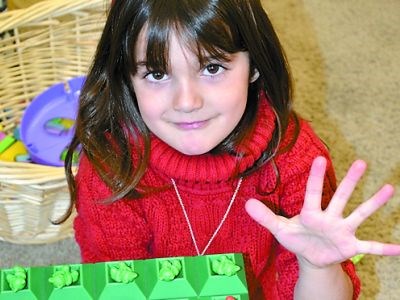In Early Learning - Kindergarten classrooms in Rainbow Schools, educators intentionally design opportunities for four- and five-year-olds to engage in mathematical problem solving.
At Central Manitoulin Public School, teacher Irene Musquetier Dewar and Early Childhood Educator Sheila McDermid set out a container of small blocks and mats. They invited a group of children to build using five blocks.
As the children build, the educators take pictures of their structures and put them into a little photo book. They suggest the children use the other structures produced by their friends as examples. By keeping the quantity constant, the children learn the number five can take many forms.
Counting to five is not as easy as it might seem. Since there is no pattern to follow, children need to memorize the numbers. They can only count each object once and, while they can start the count with any of the objects, they must preserve the order of the count.
Finally, they must recognize the last number counted refers to the set and not the object.
At Churchill Public School, teacher Jennifer Hearn asks the children to think of the many ways they can show five. The children shared their ideas.
“We use our fingers. There are five on one hand,” said Malaya Levesque.
She explained the mathematics with 25 teddy bears.
“There are five rows of five teddy bears. There are 25 teddy bears on the board — five in one row, two rows of five is 10, three rows of five is 15, four rows of five is 20, and five rows of five is 25.”
Instantly recognizing sets of five prepares children to later use mental math strategies, such as composing and decomposing numbers, without counting.
In an Early Learning – Kindergarten classroom at Princess Anne Public School, teacher Tara Thall places a bucket of two-dimensional pattern blocks on a building platform.
“What can you build with these?”
A group of children who took up the challenge soon found out that they did not have enough pattern blocks to fill the space and asked for more.
Each attempt to fill the space led to more complex patterns as the children discovered how the various shapes fit together and how designs could be repeated and extended. One of the children came up with a game. He exchanged a hexagon for two trapezoids and then asked his friends what was different.
Learning to notice patterns, to create them, and extend them is fundamental to recognizing and using the patterns that exist in all areas of mathematics.
As children investigate possible solutions, they understand that there is often more than one way to solve a problem. Educators observe children’s mathematical strategies and pose questions to reveal their thinking, such as “How do you know? Is there another way we could do this?”
Parents can support children’s mathematical interests in a number of ways. Solve problems together that require matching, sorting, comparing, measuring and weighing.
Point out patterns. Build and draw to develop spatial awareness. Play board games, card games and games with dice to develop number concept. Read books, sing songs and do finger plays that count to and from 10.
Rainbow Schools will host information nights for Full Day Every Day Junior and Senior Kindergarten later this month. Visit rainbowschools.ca for dates and times.
In the next column, we will explore self-regulation and why it’s important at school and at home.
Norm Blaseg is Director of Education for Rainbow District School Board
Join Sudbury.com+
- Messages
- Post a Listing
- Your Listings
- Your Profile
- Your Subscriptions
- Your Likes
- Your Business
- Support Local News
- Payment History
Sudbury.com+ members
Already a +member?
Not a +member?
Sign up for a Sudbury.com+ account for instant access to upcoming contests, local offers, auctions and so much more.
